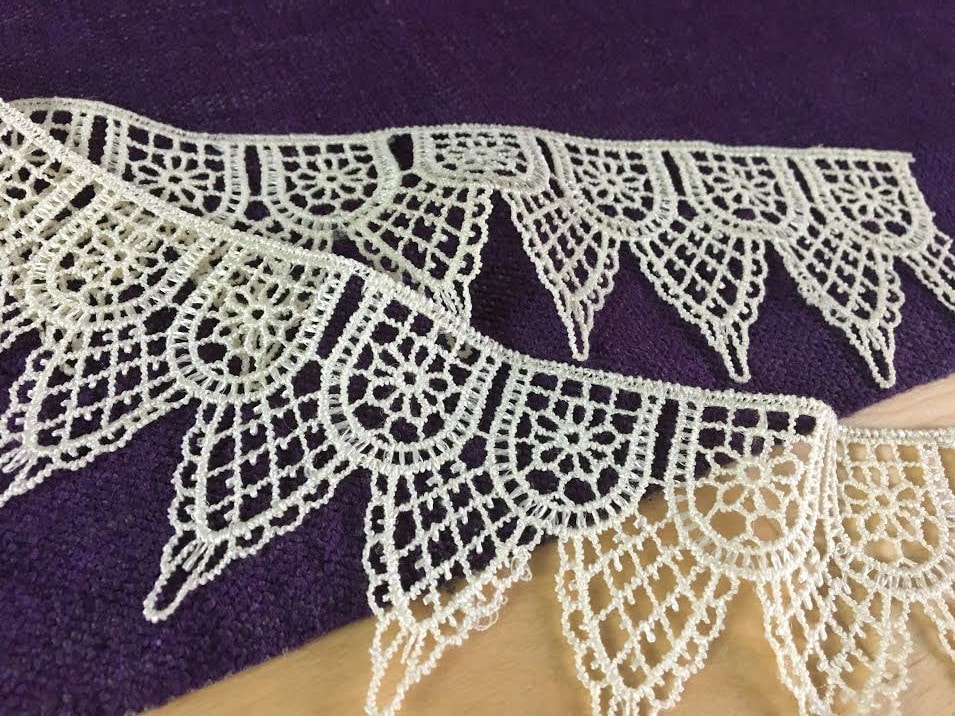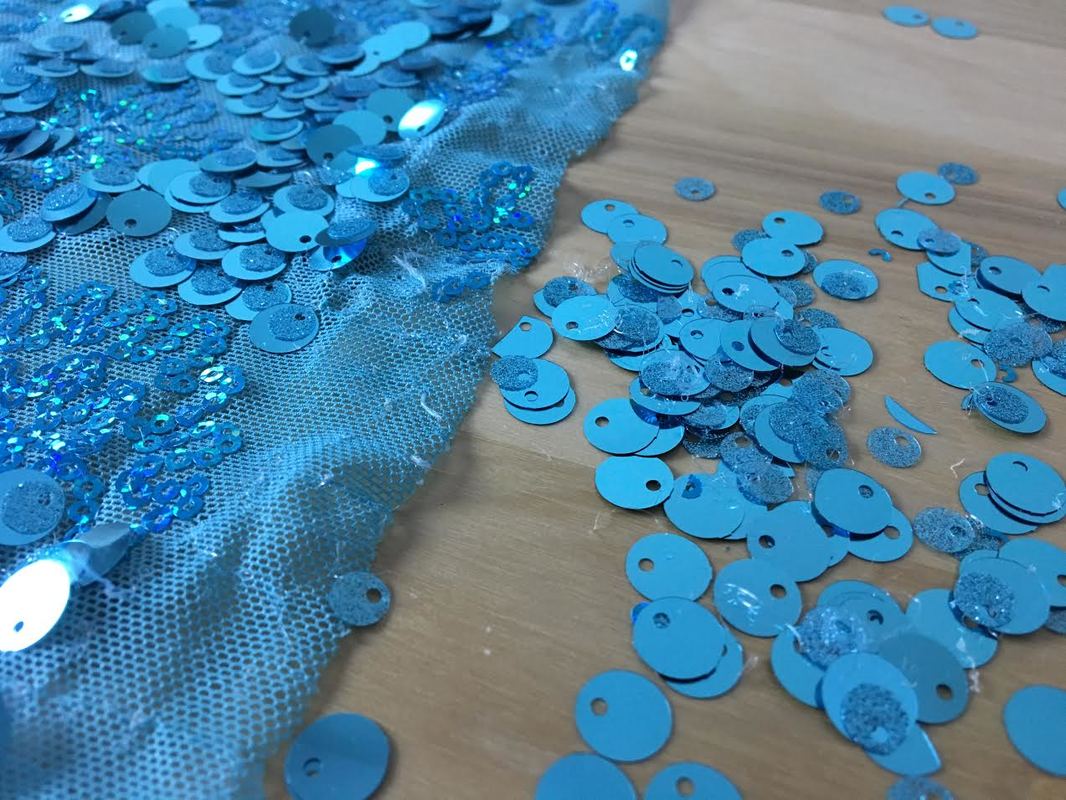|
Adding trim to a garment is a great way to elevate it's design both aesthetically and functionally. These days, there are so many different styles to choose from, ranging from conventional embroidery to specialized beaded, chain and leather trims. What they all have in common however, are the techniques used to sew them and the variety of ways they are incorporated into a garment. Based on sewing technique, you can group all trims into two large categories: Trims that can be machine stitched and trims that require hand sewing. You will certainly be able to tell the two apart based on their construction and materials used. You'll find that novelty trims featuring beaded accents, metal chains, leather cording, sequins, etc. do not offer an appropriate machine stitching "path". When you can't find an effective stitching area on a trim, it should be hand sewn to the garment instead. To permanently attach a more complex trim by hand, you can use either a blind slip stitch or a simple blanket stitch. In some cases, even if a trim can be physically machine stitched, it doesn't mean you should necessarily machine stitch it. Take a close look at the garment you are sewing and make sure the stitch applied on top of the trim will not damage or affect it aesthetically or functionally. This is often true when sewing bridal. Most wedding dresses/bridal gowns require the addition of trims along lace edges serving both an aesthetic purpose as well as a way to clean finish raw edges. In many cases, even when a machine sticthable trim is used, you may still have to hand sew it to prevent damaging the rest of the gown's lace fabric (which needs to be handled very gently). As far as trim design and style, there are a few large groups that each can be classified to. These larger groups break down into smaller ones (of course), but for the purpose of this sewing beginner tutorial, we'll just focus on the broad picture. Decorative Edge Trims: This type of trim is distinguishable by the fact that one edge is usually straight, serving as the sewing edge, while the other features a non-straight extension for the purpose of decorating a garment's hem or fabric's edge. In this tutorial, I used an embroidered edge trim that has V-shaped angular extensions along it's bottom lengthwise edge. This style is perhaps the most commonly manufactured and used in clothing design. Edge trims normally provide a distinct machine stitching edge along its top lengthwise portion making them easy to work with and convenient to attach using your sewing machine. They also come in a variety of different styles and widths. The trim used in the tutorial below is about 1.5" wide- you can choose yours based on desired look and project. While they are conventionally designed to be added to a clothing item's edge, you can add these decorative trims to the fabric surface or enclose them in a seam as desired.
5 Comments
If you are reading this tutorial, you are probably in the midst of a struggle with sewing a beaded or sequined fabric. A couple of years ago, I was wearing those shoes when I took on the enormous (yet exciting) task of designing and making my sister's wedding dress. When it comes to a project as such, lets just say the pressure is always on. Everything had to be prefect and that includes, of course, the dress fabric. As we browsed store after store, no fabric was off limits. I was ready to take on any textile regardless of how ornate or potentially difficult to work with it was. Eventually, we found the one- a luxurious lace hand beaded with two different styles of beads which beautifully blended onto the fabric surface providing a tasteful sparkle. I'll be honest, I don't recall the exact lace print itself (it was definitely floral), I do however vividly recall having to remove each minuscule bead along the fabric's cut edges in order to physically stitch the seams together. Lesson number 1? Sewing with heavily beaded and sequined fabrics requires a lot of patience. The end result however, is incredibly rewarding. Precautions For Sewing With Beaded And Sequined FabricsAs you might have already guessed, sewing with beaded or sequined fabrics will take a bit more energy than working with regular fabrics. There a few aspects of taking on these unique fabrics that require a different construction (and sometimes design) process than that conventionally used with non-ornamental fabrics.
|
The Blog:A journey into our design process, sewing tutorials, fashion tips, and all the inspiring people and things we love. Doina AlexeiDesigner by trade and dressmaker at heart. I spend most of my days obsessing over new fabrics and daydreaming new ideas. Sadie
Executive Assistant & Client Relations Manager Archives
November 2019
Categories
All
|
-
Sewing Tutorials
-
Basics
>
- Aligning Pattern Grainlines To Fabric
- Preparing Fabrics For Sewing
- Pinning Sewing Patterns To Fabric
- Placing Sewing Patterns On Fabric For Cutting
- Rotary Cutters or Fabric Scissors?
- Cutting The Sewing Patterns
- What Are Notches And How To Use Them In The Sewing Process
- Transferring Notches From Pattern To Fabric
- Transferring Seamlines to Fabric
- Staystitching
- Backstitching: A Complete Guide
- Hand Basting: A Complete Guide
- Sewing Continuous Bias Binding
- Darts >
-
Sewing Seams
>
- The Basics Of Seams And Seam Allowance
- How To Sew A Straight Seam
- Sewing Curved Seams
- Sewing Corner Seams
- Trimming And Grading Seam Excess
- Notching/Clipping Seam Allowance for Tension Release
- Sewing Topstitched Seams
- Sewing Corded Seams
- Sewing A Slot Seam
- Sewing A Gathered Seam
- Sewing Bias Seams
- Sewing Seams With Ease
- Sewing Seams With Crossing Seamlines
- Sewing Unlike Fabric Seams
- How To Iron Seams: Ironing Tools And Conventions
- Sewing With Knit Fabrics
- Understanding Stitch Length And Tension
- Sewing Unique Fabric Seams
-
Seam Finishes
>
- Seam Finishing Techniques - Overview
- Applying A Pinked Seam Finish
- Applying A Bias Bound Seam Finish
- Serging And Zigzag Seam Finishes
- Sewing A Self-Bound Seam Finish
- Sewing A French Seam Finish
- Sewing A Hong Kong Seam Finish
- Sewing A Mock French Seam Finish
- Sewing A Turned-and-Stitched Seam Finish
- Sewing Overcast Hand-Applied Seam Finishes
- Sewing A Flat Felled Seam
- Sewing A Hairline Seam Finish
-
Hem Finishes
>
- Garment Hem Finishes: Overview
- Sewing A Double Fold Hem Finish
- Sewing A Single Fold Hem Finish
- Sewing Bound Hem Finishes
- Sewing An Exposed Double Layer Bound Hem
- Sewing A Folded-Up Bound Hem with Pre-folded Binding
- Sewing A Hong Kong Hem Finish
- Sewing A Band Hem Finish
- Sewing A Bias Faced Hem Finish
- Sewing A Twill Tape Hem Finish
- Sewing A Rolled Hem Finish
- Sewing A Shaped Hem Facing
- Using Fusible Hem Tape And Webbing
- Finishing A Lace Fabric Hem
- Finishing A Leather Hem
- Sewing Faced Hem Corners
- How To Finish Lining At The Hem
- Finishing Fabric Corners by Mitering >
- Interfacing A Hemline: Lined And Unlined Examples
-
Sewing Pockets
>
- Curved Patch Pocket With Flap
- Unlined Square Patch Pockets
- Lined Patch Pockets: Two Ways
- Extension On-Seam Pockets
- Separate On-Seam Pocket
- Front Hip Pockets
- Bound Double Welt Pocket
- Double Welt Pocket With Flap
- Self-Welt Pocket (Using Single Fabric Layer)
- Slanted Welt Pocket (Hand-Stitched)
- Faced Slash Pockets: Overview >
-
Sewing Zippers
>
- Sewing Zippers: General Information
- Sewing A Centered Zipper
- Sewing A Lapped Zipper
- Sewing An Invisible Zipper
- Sewing A Fly Front Zipper
- Sewing A Closed-End Exposed Zipper (No Seam)
- Sewing An Exposed Separating Zipper
- Sewing Hand Stitched Zipper Applications
- Sewing A Zipper Underlay
- Sewing A Placket-Enclosed Separating Zipper
- Sleeveless Finishes >
-
Neckline Finishes
>
- Sewing A Neck Shaped Facing
- Sewing An All-In-One Neck Facing
- Neck And Garment Opening Combination Facings >
- Sewing A Bias Faced Neckline Finish
- Sewing A Band Neckline Finish
- Bound Neckline Finishes: Overview >
- Sewing A Semi-Stretch Strip Band Neckline
- Ribbed Neck Band And Classic Turtleneck
- Decorative Neckline Finishes >
- Finishing Facing Edges >
-
Extras
>
- A Complete Guide on Interfacing
- Sewing Bound Spaghetti Straps
- Sewing Spaghetti Straps To A Faced Neckline
- Sewing Ruffles: Overview
- Patterning And Sewing A Circle Ruffle
- Sewing A Gathered Heading Ruffle
- Sewing Double Layer Gathered Ruffles
- Sewing A Gathered Ruffle Into A Seam
- Sewing A Gathered Ruffle To A Fabric Edge
- Sewing A Fabric Surface Slit
- Sewing A Slit Seam
- Hand-Applied Straight Stitches
- Hand-Applied Blind Stitches
- Hand-Applied Overedge Stitches
- Hand-Applied Tack Stitches
- Hand-Applied Decorative Stitches
-
Basics
>
- Custom Bridal
- Custom Apparel
- About
- Blog
Services |
Company |
|





 RSS Feed
RSS Feed

